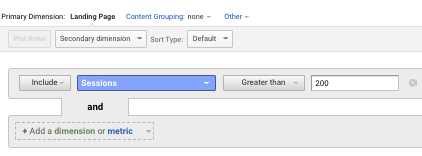
Many people talk about how important it is to have a “low bounce rate.”
But bounce rate is one of the most misunderstood metrics in digital marketing.
This article will explore the complexities of bounce rate and why it’s not as straightforward as you might think.
You’ll also learn how to audit your bounce rate and what you can do to improve website engagement.
What Is a Bounce?
The short and simple answer is: “A bounce is when a user enters your website on a particular page and leaves from that very same page without taking any other actions.”But if only it were as simple as that. Let’s dig a little deeper.
How Is Bounce Rate Calculated?
First things first, we need to understand how we come up with this metric. There are three ways to look at it:- Page level Bounce Rate: Total number of bounces on a page (in a particular date range) divided by the total number of entrances (first pageview hit) on the page (in that same date range).
- Sitewide Bounce Rate: Total number of bounces across all the pages on the website (in a particular date range) divided by the total number of entrances across all the pages on the website (in that same date range).
- Segmented Bounce Rate: Total number of bounces across all the pages on a particular segment (selection of pages) of the website (in a particular date range) divided by the total number of entrances across all the pages on that segment of the website (in that same date range).
If I landed and visited a second page, that would mean the bounce rate for that session was 0 percent.
The calculations above put that logic into practice at a larger scale.
Bounce Rate Isn’t What You Thought
However, it’s not only visiting a second page which brings bounce rate down.Did you know that you can have a 0 percent bounce rate even if a user left after only visiting one page?
Yup, when setting up Events, you can make Google Analytics (GA) count any Event hit as an ‘Interaction’ and therefore reduce ‘Bounce Rate’ even if a user didn’t visit a second page of your website.
For example, if you had an Event on a particular element of a page (like playing a video), and set GA to count the Event as an ‘Interaction’, users could visit that one page where the video features, click play, and then leave from the same page (without navigating further).
But the bounce rate for that session would be 0 percent (even though the user didn’t actually move to a second page on your site).
This is known as ‘Adjusted Bounce Rate’ (when you adjust the default settings for the way Google Analytics handles Interactions).
Further Complications
So, it’s not as straightforward as saying “example.com has a bounce rate of 43 percent and example2.com has a bounce rate of 57 percent, therefore example.com performs better.”In actual fact, it may be that example2.com performs way better but has set up their Events as Non-Interaction Hits (and therefore even if the user plays the video, the bounce rate in a session like the one mentioned above would be 100 percent unless the user navigated to a second page).
On top of that, what use is there in measuring bounce rate for the whole website when you have lots of different templates, which are laid out and designed in different ways?
Your bounce rate for blog pages is going to be higher than the bounce rate for product pages or service pages and so on.
For example, Google says: “If you have a single-page site like a blog, or offer other types of content for which single-page sessions are expected, then a high bounce rate is perfectly normal.”
Traffic Source Makes a Big Difference
Bounce rate can be wildly different depending on the source of traffic.For example, it’s likely that search traffic will produce a low bounce rate while social and display traffic might produce a high bounce rate.
So you also have to consider bounce rate on a channel level as well as on a page level.
Bounce rate from social and display is almost always higher than “inbound” channels for these reasons:
- When a user is on social media looking through their news feed, they are (often) not actively looking for what we are promoting.
- When a user sees a banner ad on another website, they are (often) not actively looking for what we are promoting.
So you capture their attention during the “doing” phase of their buyer’s journey (depending on the search term in question).
High Bounce Isn’t Always Bad
As Google mentioned (quoted above), high bounce rate is not always bad.If you’re Googling [what’s on at the cinema…], then land on a website and have to dig through five pages of the site to find what’s showing, you’re having a bad experience and the cinema would see a 0 percent bounce rate on their website.
In this case, that’s misleading if you consider low bounce rate to be good.
Now, if you Google that same phrase, then find a page which gives you the answer and then exit from that very page, go to the cinema, and buy four tickets, you’re having a good experience.
The cinema is having an even better one by transacting four tickets, but they had a 100 percent bounce rate on their website for that particular session!
All that to say, all is not as it may seem with bounce rate. You need to analyze it at a much deeper level to fully understand if your bounce rate is “good” or “bad.”
Bounce Rate Isn’t Part of Google’s Ranking Algorithm
Don’t worry, despite the “professional opinion” of many SEO cowboys, bounce rate isn’t part of Google’s algorithm.No, having a low bounce rate won’t give you “ranking benefits.”
Google has told us numerous times over the past decade.
Yes, Google likely uses some sort of engagement measurements in their algorithm, but it isn’t bounce rate from Google Analytics.
In fact, they don’t use any metrics from Google Analytics as we know them, as Googler Gary Illyes tweeted:
How Low Can Your Bounce Rate Go?
All that said, I must confess, 9 times out of 10, I would rather have a low bounce rate.In most cases, it shows your marketing is effective and well-targeted and visitors are engaging with your content and want to know more.
But how can you change bounce rate and give visitors a better experience?
Read on and find out.
Bounce Rate Audit
Next time your boss or client asks you “why is my bounce rate so high?” – first, send them this article.Second, conduct an in-depth bounce rate audit to understand what’s going on.
Here’s how I do it.
Set the Dates
Look at bounce rates on your website for a particular time period. Dig deep into different segments to see if one particular segment is higher than others.Maybe there was a particular change you made to the website that had an influence on bounce rate.
Google Analytics will help you find out.
Compare Against Others in Your Industry
Check Google Analytics: Audience > Behaviour > Benchmarking > Channels.Choose your vertical and compare the time period you’re interested in.
There you’ll see something like this and be able to get a good idea of how your website’s bounce rate performs by channel.

Analyze Your Bounce Rates by Channel
On that chart above you are looking at bounce rates by channel, but compared to other Google Analytics accounts (Properties) in your industry.You can go deeper into this by looking at: Acquisition > All Traffic > Channels > Click the ‘Comparison’ button on the right as shown below and filter by ‘Bounce Rate’ to see which Channels are above or below average.
Then, dig deeper into each one.

Analyze Bounce Rate on a Page Level
On Google Analytics: Behaviour > Site Content > Landing Pages.Then filter by highest bounce rate first by clicking the top of the bounce rate column.
Note: To ensure the data you’re mining is statistically significant, it’s worth filtering to only show data with Sessions greater than say 200 (or whatever number you deem suitable).
Otherwise, you’ll be looking at bounce rates on some pages with only one or two sessions, which doesn’t tell you anything.
You can do this using a Secondary Dimension as shown below: Include > Sessions > Greater than > 200.

Once you’ve done the above, do the same again per channel to get an even more rounded understanding of what kinds of content/source combinations produce the most or least engaged visits.
Something Fishy Going On?
Sometimes you’ll find pages which rank in search engines for terms that have more than one meaning.For example, a recent one I discovered was a page on a website I manage which ranks first for the search term ‘Alang Alang’ (the name of a villa), but, Alang Alang is also the name of a film.
The villa page had a high bounce rate and one of the reasons for this is down to some of the visitors landing on that page actually looking for the film, not the villa.
By doing some keyword and competition research to see what kinds of results your target keywords produce, you can quickly understand if you have any pages that rank well for terms that could be intended for other topics.
When you identify such pages, you have three options:
- Completely change your keyword targeting.
- Remove the page from the SERPs.
- Overhaul your title and meta description so searchers know explicitly what the page is about before they click.
Connect the Dots
Now dig deeper into the data you’ve found by looking for patterns or reasons that one page or set of pages/source or set of sources has a higher or lower bounce rate.Compile the information in an easy to read format and ping it to the powers that be and head for a congratulatory coffee.
How to Increase Website Engagement
Now you’ve figured out what’s going wrong, you’re all set to make some changes.All of this depends on the findings of your study so not all of these points are relevant to every scenario, but this should be a good starting point.
- Design and user experience improvements.
- Conversion rate optimization.
- Improving calls to action.
- Better copywriting.
- Create outstanding content.
- Communicate special offers.
- Speed up page load time.
- Improve your targeting for paid advertising.
- Reassess your keyword targeting for SEO.
- Ensure landing page messages match targeting.
- Implement live chat to coach visitors to your goals.
- Focus more on marketing channels with low bounce.
- Weed out pages from your website which have a high bounce.
- Create certain events as “interaction” hits so things like playing a video result in Google Analytics classifying that as a none bounce even if the user didn’t visit a second page.
Summary
Hopefully you now understand why bounce rate isn’t simply “high” or “low.”Bounce rate is much more complex and depends on so many factors.
Never assume anything. Do your research.
The moral of the story: don’t judge a book by its cover, for once you start turning pages you’ll discover a whole different story.
Reference:https://www.searchenginejournal.com/what-is-bounce-rate-how-to-audit/240555/?ver=240555X2
No comments:
Post a Comment